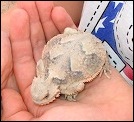Mammals
About 70 mammal species live in Snake Valley. At the top of the food chain are mountain lions, bobcats, coyotes, and foxes. Large ungulates include bighorn sheep, elk, mule deer, and pronghorn antelope. Some of the smaller mammals have interesting life traits, like porcupines, badgers, weasels, and bats. Watch out for these larger species as you drive at night, as they often are not visible until they are in your headlights. Click here for a mammal species list.
Fish
Snake Valley has seven species of native fish, most likely remnants of the ancient Lake Bonneville. These are Bonneville cutthroat trout, Utah chub, Utah sucker, mottled sculpin, redside shiner, speckled dace, and least chub. These fish, for the most part, have adapted to live in small mountain streams and isolated springs, and geneticists find that some of the species have differentiated from relatives that live nearby (like along the Wasatch Front). Snake Valley is a stronghold for least chub, and the populations here are helping to keep the species genetically healthy and viable. The tiny fish are only found in the north part of Snake Valley, and every year the Utah Division of Wildlife Resources comes out to assess their populations. View a fish list for Snake Valley.
Amphibians
Frogs are not common in Snake Valley, but in a few places they can become so loud as to drown out all other sounds. Amphibians seen most frequently are northern leopard frogs, often in grass near a water source; spadefoot toads, usually away from water; and Columbia spotted frogs, with eyes barely visible above the water. See the amphibian list for Snake Valley.
Reptiles
Snakes and lizards comprise the reptiles in Snake Valley. Only one poisonous snake, the Great Basin rattlesnake, is found, and its poison is reportedly less dangerous than other rattlesnakes. Garter snakes are common near water sources and gopher snakes help keep rodent populations in control. The most common lizards on the valley bottom are horned lizards, while up higher sagebrush and western fence lizards scurry about. The reptiles go into a dormant period during the winter, hiding out in loose soil or in burrows to escape the cold temperatures. Click for the Snake Valley reptile list.
Birds
Snake Valley is a birding mecca. With the scattered oases, varied elevations, agricultural areas, and strong wind currents, a large number of birds find that Snake Valley is a good place to call home or to visit. Over 180 species have been noted in the valley. Some bald eagles spend their winters here, while in the summers sandhill cranes hang out. Up high, the black rosy-finch picks at insects in high snow patches, and the peregrine falcon soars over the high cliffs. View a bird list for Snake Valley.
Insects

Spiders/Centipedes/Millipedes/Etc.












